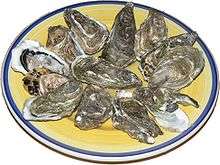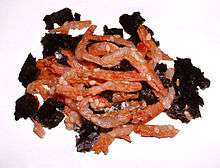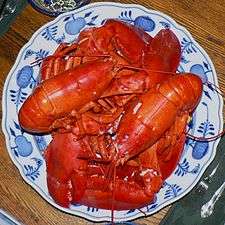Shellfish

Shellfish is a culinary and fisheries term for exoskeleton-bearing aquatic invertebrates used as food, including various species of molluscs, crustaceans, and echinoderms. Although most kinds of shellfish are harvested from saltwater environments, some kinds are found in freshwater. In addition a few species of land crabs are eaten, for example Cardisoma guanhumi in the Caribbean.
Despite the name, shellfish are not a kind of fish, but are simply water-dwelling animals. Many varieties of shellfish (crustaceans in particular) are actually closely related to insects and arachnids, making up one of the main classes of the phylum Arthropoda. Cephalopods (squid, octopus, cuttlefish) and bivalves (clams, oysters) are molluscs, as are snails and slugs.
Familiar marine molluscs enjoyed as a food source by humans include many species of clams, mussels, oysters, winkles, and scallops. Some crustaceans commonly eaten are shrimp, lobster, crayfish, and crabs.[1] Echinoderms are not as frequently harvested for food as molluscs and crustaceans; however, sea urchin roe is quite popular in many parts of the world.[2][3]
Most shellfish eat a diet composed primarily of phytoplankton and zooplankton.[4]
Shellfish are among the most common food allergens.[5]
Terminology

The term shellfish is used both broadly and specifically. In common parlance, as in having "shellfish" for dinner, it can refer to anything from clams and oysters to lobster and shrimp. For regulatory purposes it is often narrowly defined as filter-feeding molluscs such as clams, mussels, and oyster to the exclusion of crustaceans and all else.[6]
Although the term is primarily applied to marine species, edible freshwater invertebrates such as crayfish and river mussels are also sometimes grouped under the umbrella of "shellfish".
Although their shells may differ, all shellfish are invertebrates. As non-mammalian animals that spend their entire lives in water they are "fish" in an informal sense; however the term finfish is sometimes used to distinguish fish as animals defined by having vertebrae from shellfish in modern terminology.
The word "shellfish" is both singular and plural; the rarely used "shellfishes" is sometimes employed to distinguish among various types of shellfish.[7]
Shellfish in various cuisines
Archaeological finds has shown that humans have been making use of shellfish as a food item for hundreds of thousands of years. In the present, shellfish dishes are a feature of almost all the cuisines of the world, providing an important source of protein in many cuisines around the world, especially in the countries with coastal areas.

In Japan
In the Japanese cuisine, chefs often use shellfish and their roe in different dishes. Sushi (vinegared rice, topped with other ingredients, including shellfish, fish, meat and vegetables) features both raw and cooked shellfish. Sashimi primarily consists of very fresh raw seafood, sliced into thin pieces. Both sushi and sashimi are served with soy sauce and wasabi paste (a Japanese horseradish root, a spice with extremely strong hot flavor), thinly-sliced pickled ginger root, and a simple garnish such as shiso (a kitchen herb, member of the mint family) or finely shredded daikon radish, or both.
In the United States

Lobster in particular is a great delicacy in the United States, where families in the Northeast region make them into the centerpiece of a clam bake, usually for special occasions. Lobsters are eaten on much of the East Coast; the American lobster ranges from Newfoundland down to about the Carolinas, but is most often associated with Maine. A typical meal involves boiling the lobster with some slight seasoning and then serving it with drawn butter, baked potato, and corn on the cob.
Clamming is done both commercially and recreationally along the Northeast coastline of the US. Various type of clams are incorporated into the cuisine of New England. The soft-shelled clam is eaten either fried or steamed (and then called "steamers"). Many types of clams can be used for clam chowder, but the quahog, a hard shelled clam also known as a chowder clam, is often used because the long cooking time softens its tougher meat.
The Chesapeake Bay and Maryland region has generally been associated more with crabs, but in recent years the area has been trying to reduce its catch of blue crabs, as wild populations have been depleted. This has not, however, stemmed the demand: Maryland-style crabcakes are still a well known treat in crabhouses all over the bay, though the catch now comes from points farther south.
.jpg)
In the Southeast, and particularly the gulf states, shrimping is an important industry. Copious amounts of shrimp are harvested each year in the Gulf of Mexico and the Atlantic Ocean to satisfy a national demand for shrimp. Locally, prawns and shrimp are often deep fried; in the Cajun and Creole kitchens of Louisiana, shrimp and prawns are a common addition to traditional recipes like jambalaya and certain stews. Crawfish[8] are a well known and much eaten delicacy here, often boiled in huge pots and heavily spiced.
In many major cities with active fishing ports, raw oyster bars are also a feature of shellfish consumption. When served freshly shucked (opened) and iced, one may find a liquid inside the shell, called the liquor. Some believe that oysters have the properties of an aphrodisiac.
Inter-tidal herbivorous shellfish such as mussels and clams can help people reach a healthy balance of omega-3 and omega-6 fats in their diets, instead of the current Western diets.[9] For this reason, the eating of shellfish is often encouraged by dietitians. Shellfish, however, are a rich source of the amino acid taurine.
Around the world


Shellfish is a common part of indigenous cuisines throughout the globe.
Some popular dishes using shellfish:
- Ceviche
- Cioppino
- Callaloo
- Clam chowder
- Curanto
- Fruits de mer
- Paella
- Sashimi
- Shrimp cocktail
- Lobster bisque
- She-crab soup
- Sliced fish soup
- Sushi
- Shrimp Saganaki
Religious dietary restrictions
The Old Testament forbids the consumption of shellfish, particularly in the books of Leviticus and Deuteronomy.[10] Orthodox Jews therefore do not eat shellfish.
Toxic content
Some shellfish, such as whelk, contain arsenic. A sample of whelk was found to have a total content of arsenic at 15.42 mg/kg of which 1% is inorganic arsenic.[11]
Nutritional Values
| Shellfish | Protein(g) | Fat(g) | Sodium(mg) |
|---|---|---|---|
| Oysters(raw) | 10.8 | 1.3 | 5.0 |
| Mussels (boiled) | 16.7 | 2.7 | 360 |
| Clams(canned) | 16.0 | 0.6 | 1200 |
| Shrimps(boiled) | 23.8 | 2.4 | 3840 |
| Prawns(boiled) | 22.6 | 0.9 | 1590 |
| Lobsters(boiled) | 22.1 | 1.6 | 330 |
| Crayfish(raw) | 14.9 | 0.8 | 150 |
| Crabs(boiled) | 19.5 | 5.5 | 420 |
| Cuttlefish(raw) | 16.1 | 0.7 | 370 |
| Octopus(raw) | 17.9 | 1.3 | 120 |
| Squid(raw) | 15.4 | 1.7 | 110 |
See also
Notes
- ↑ "Shellfish climbs up the popularity ladder; the category is gaining chefs' attention for one-of-a-kind signature menu items". HighBeam Research. Retrieved 2009-08-25.
- ↑ Fabricant, Florence (1998). "Sea urchin makes waves, popularity increases on American menus". Nation's Restaurant News via BNET. Retrieved 2009-08-25.
- ↑ "The sea urchin market in Japan". Marine Fisheries Review via BNET. 1989. Retrieved 2009-08-25.
- ↑ "Manual on the Production and Use of Live Food for Aquaculture". Food and Agriculture Organization of the United Nations. Retrieved 2009-08-25.
- ↑ "Shellfish Alergies". Cleveland Clinic. Retrieved 2009-08-25.
- ↑ Maryland Shellfish Harvesting Areas, Maryland Department of the Environment
- ↑ Festing, Sally (1999). Fishermen: A Community living from the Sea (Revised ed.). Stamford: Shaun Tyas. p. 119. ISBN 978-1-900289-22-1.
- ↑ "Crawfish Nutritional Facts" Valuepenguin.com
- ↑ Robson, A. 2006. "Shellfish view of omega-3 and sustainable fisheries." Nature 444, 1002.
- ↑ Leviticus 11:9-12
- ↑ "82/05 October 2005 Arsenic in fish and shellfish" (PDF). food.gov.uk. 2010-09-08. Retrieved 2013-04-06.
References
- Pawley, Andrew (2004) "Are crustaceans shellfish? A whiff of scandal in English lexicography" Australian Style, 12 (1): 1–3.
External links
| Wikibooks Cookbook has a recipe/module on |
- BC Shellfish Growers Association
- East Coast Shellfish Growers Association
- Pacific Coast Shellfish Growers Association
- Shellfish News
- Shellfish Gallery
- Shellfish Guide
- Freshwater and Marine Image Bank—Shellfish at the University of Washington Libraries, Digital Collection
- Nutrition Facts for Various Shellfish
| ||||||||||||||||||||||||||||||||||||||||
|

